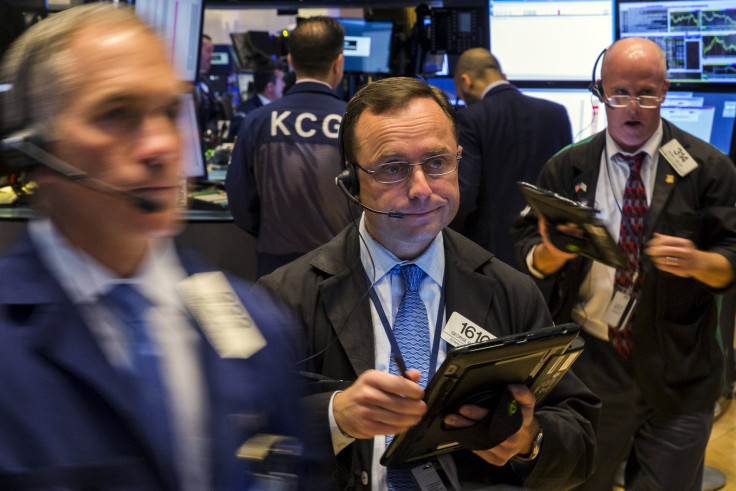Dow Jones Industrial Average Tumbles 150 Points After Wal-Mart Stores Inc. (WMT) Sinks 10%

U.S. stocks closed sharply lower Wednesday, with the Dow Jones Industrial Average tumbling more than 150 points, after a series of mixed economic reports and earnings results raised questions on whether the Federal Reserve will raise the cost of borrowing for the first time in nearly a decade. Eight of the 10 sectors in the Standard & Poor's 500 index closed lower, led by declines in consumer staples, industrials and financial stocks.
“Uncertainty surrounding the rate lift-off date continues to add to investor angst and concern,” U.S. Bank Wealth Management said in its weekly Market & Economics report.
The Dow snapped a seven-day losing streak after shares of Wal-Mart Stores Inc. (NYSE:WMT) tumbled 10 percent, erasing around $20 billion in market value and putting the stock on course for its worst trading day in nearly 15 years.
The world’s largest retailer warned that sales growth would be flat this year, and forecast revenue to drop next year. The Bentonville, Arkansas-based company also authorized $20 billion in stock buybacks over the next two years.
The Dow Jones Industrial Average (INDEXDJX:.DJI) plunged 157.14 points, or 0.92 percent, to close at 16,924.75. The Standard & Poor's 500 index (INDEXSP:.INX) lost 9.45 points, or 0.47 percent, to finish at 1,994.24. The Nasdaq composite (INDEXNASDAQ:.IXIC) fell 13.76 points, or 0.29 percent, to end at 4,782.85.
The U.S. Federal Reserve’s latest Beige Book, released Wednesday, revealed the strong U.S. dollar was hurting the manufacturing sector mid-August through early October, according to anecdotal comments from contacts outside the Federal Reserve. Meanwhile, China, the world’s second-largest economy, also continued to weigh on businesses during the same period, the Fed said in the report.
The Beige Book, which the central bank publishes eight times a year, highlights the current condition of the U.S. economy in each of the Fed's 12 districts.
Fed officials delayed an interest rate increase in September because of growing risks to the central bank's economic growth outlook, driven mainly from China, minutes from the Federal Open Market Committee showed.
U.S. retail sales mildly rose in September, partly due to a 3.2 percent drop in the value of sales at gasoline stations, raising doubts about whether Federal Reserve policymakers will raise rates this year.
“The softness of September’s retail sales figures supports our view that the Fed probably isn’t going to hike interest rates until early next year,” Paul Ashworth, chief U.S. economist at Capital Economics, said in a research note Wednesday.
Retail sales were up 0.1 percent last month after being revised lower in August, the Commerce Department said Wednesday. Economists polled by Reuters had expected retail sales to rise 0.2 percent, while sales in August were revised flat after a previously reported 0.2 percent increase.
Separately, U.S. producer prices posted their biggest decline in eight months, weighed down by lower energy prices and strong U.S. dollar.
The producer price index fell 0.5 percent in September, the biggest decline since January, after being unchanged in August, the Labor Department said Wednesday.
However, economists expect rising activity will drive a gradual rebound in inflationary pressures. “Low oil prices and the strong dollar pass-through will clamp down on prices, but inflation should slowly rebound as the economy continues to grow,” Gregory Daco, head of U.S. macroeconomics at Oxford Economics, said in a note.
Meanwhile, Wall Street continued to eye third-quarter earnings season, with two major U.S. banks reporting results Wednesday.
The financial sector was looking to benefit from a raise in interest rates this year, as a hike in rates would improve the net interest margins of large banks. However, the financial sector may have to wait if the Fed delays changing its monetary policy stance this year.
Shares of Bank of America Corp. (NYSE:BAC) edged up nearly 1 percent after the Charlotte, North Carolina, company turned in a quarterly profit, compared with a year-earlier loss, helped by cost-cutting efforts.
Meanwhile, shares of Wells Fargo & Co. (NYSE:WFC), the biggest U.S. residential mortgage lender, posted its first rise in quarterly profits in three quarters, boosted by its purchase of commercial loans from General Electric Company.
© Copyright IBTimes 2024. All rights reserved.






















